Hands On with USB Type C: Reversible USB Connectors
by Joshua Ho on September 11, 2014 9:00 AM EST- Posted in
- Smartphones
- Mobile
- Laptops
- Tablets
- USB-IF
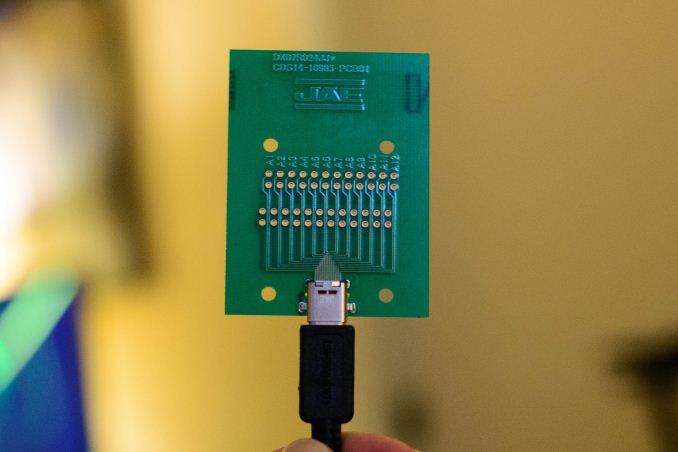
Today, the USB-IF brought me in to see the long-awaited USB Type C cables. We've written about this before, but for those that aren't familiar with this new USB spec, the USB Type C cable and USB 3.1 spec are designed with the future in mind. As a result, there are a lot of new features to talk about. We'll start with the USB 3.1 spec before we get into the Type C connector.
With USB 3.1, we see a few key improvements. Peak throughput goes to 10 Gbps from 5 Gbps, which translates to a peak of 1.25 GB/sec. In a demo of an early controller with two SSDs attached to the system I saw peak throughput of 833 MB/sec. As a side note, I also saw a demo of wireless USB connectivity from smartphone to laptop and laptop to smartphone, which was definitely pretty cool. Getting back to the USB 3.1 spec, USB Power Delivery 2.0 (PD) makes it possible for USB to supply up to 100 watts, and coexists with the BC 1.2 spec that is used in USB power adapters to charge phones so a single port would be able to provide power for both systems. In addition, USB PD 2.0 allows for power to go both ways without changing the direction of the cable, so a laptop would be able to send and receive power from the same port. Finally, USB Type-C extensions mean that it's possible to do all kinds of interesting applications over USB ports, such as sending audio and video data. It's even possible for a USB Type C port to send PCI-E data through the connection for use cases such as a two in one convertible tablet.
This opens up the possibility for a dock scenario where a single cable to the monitor can charge a laptop and also mirror the laptop's display onto the external monitor, and the external monitor would also be able to serve as a USB hub for a keyboard, mouse, headsets, flash drives, and other USB peripherals. While the laptop charging aspect and integrated USB hub in display wasn't demonstrated in the prototype I saw, everything else was fully working as shown in the photo above.
I was also able to get some photos of the cable and receptacle. Unfortunately it took flash to really show the detail in the connector but it definitely will be a great standard for all kinds of applications. While I'm sure that there will be differences in the final product, the reversible plug works just like expected and could be quickly inserted from behind the back. The USB-IF believes that this standard will show up in products shipping in 2015. It does seem that the connector is a bit less compact than microUSB, but the benefits outweigh this increase in size.


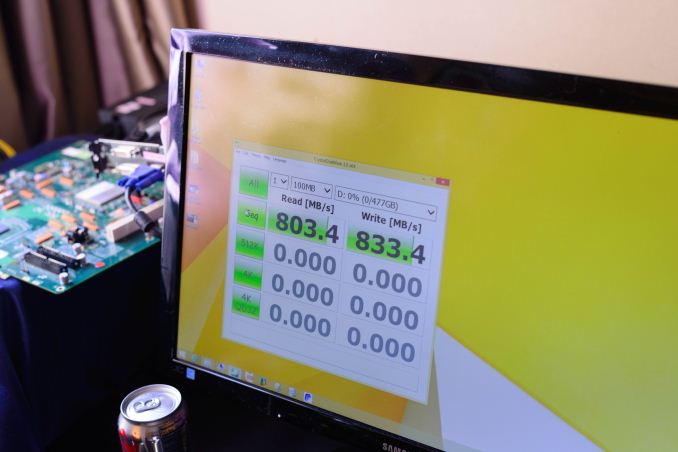
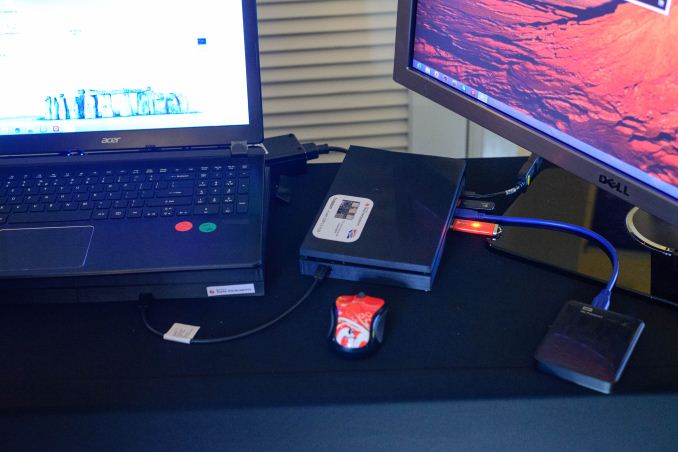
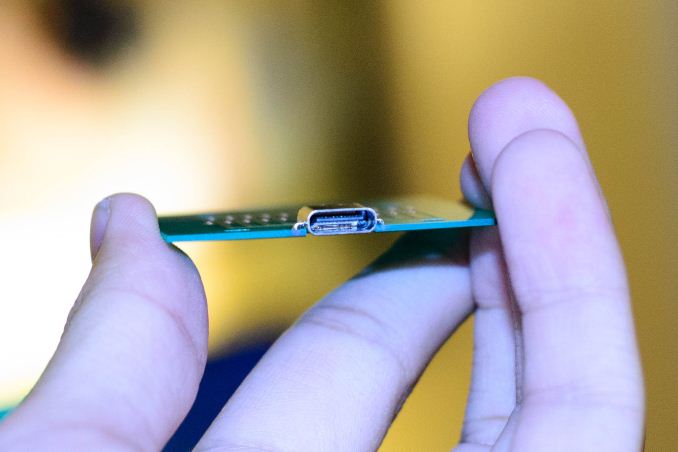
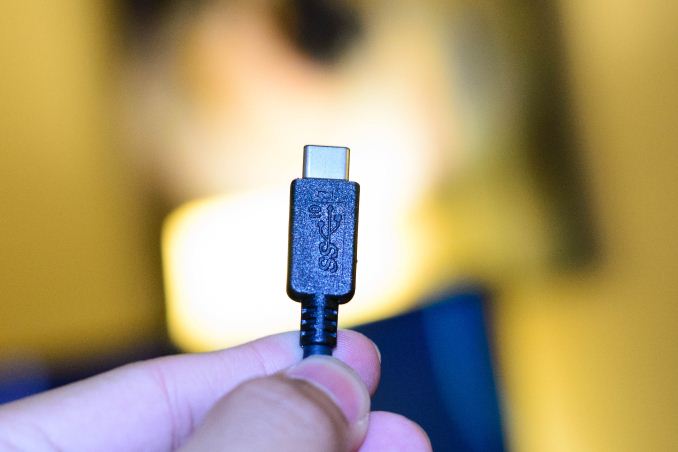
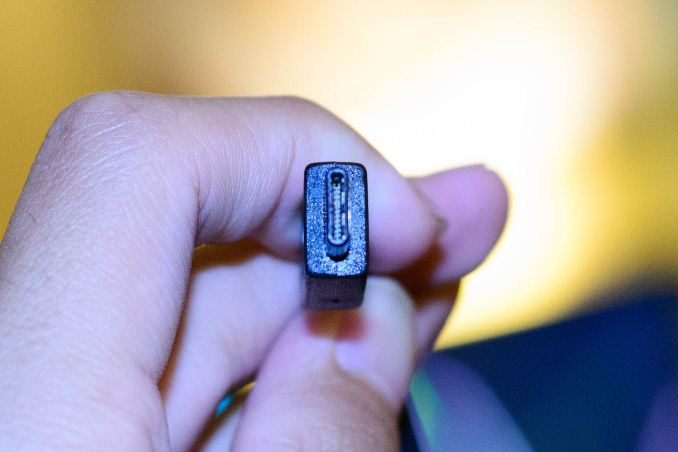








91 Comments
View All Comments
seibert - Thursday, September 11, 2014 - link
As part of the power negotiation, the devices can decide raise the voltage on the power rails to 12V or 20V. In both cases, the current limit is 5Aseibert - Thursday, September 11, 2014 - link
12V is the voltage used now by "high power" USB ports to charge devices like tablets.Zotamedu - Thursday, September 11, 2014 - link
They wont deliver 100 W at 5 V. USB 3.1 added 12 V and 20 V on top of the standard 5 V. Both new voltages have a limit of 5 A. So ju can draw 60 W at 12 V or 100 W at 20 V. The device needs to request the higher voltages so 5 V will continue to be the standard.hyasinth - Thursday, September 11, 2014 - link
Hopefully that means we might start seeing Laptops and maybe even HTPCs being charged off USB!azazel1024 - Thursday, September 11, 2014 - link
It isn't at 5V. The 100w is at 24v.IIRC, the USB power delivery spec will be up to 10W using 5V (IE 2A), then up to 20W using 10V (IE 2A again) and up to 100W using 24V (IE 4A). No way could you make a realistic cable and connector to handle 20A, so you've gotta increase the voltage.
It auto negotiates the voltage and ameperage when connecting.
azazel1024 - Thursday, September 11, 2014 - link
Bah, beatten to it and also posted incorrect numbers. 20V@5A is the max.PICman - Thursday, September 11, 2014 - link
Thanks to azazel1024 and others - this makes sense.Marquis - Thursday, September 11, 2014 - link
It should be noted that while USB Type-C connectors may not be quite as small as MicroUSB 2.0, they're substantially smaller than any of the prior USB 3.0 connectors.SleepyFE - Thursday, September 11, 2014 - link
I think miniUSB 3.0 is a bit smaller, but not usefully so.mkozakewich - Thursday, September 11, 2014 - link
It depends what 'smaller' means. I took it to mean it'll be a bit thicker. Obviously a wide-but-thin connector would be ideal on phones that need to be ultra-thin. Honestly, though, I think I'd appreciate the increased thickness for something like this.